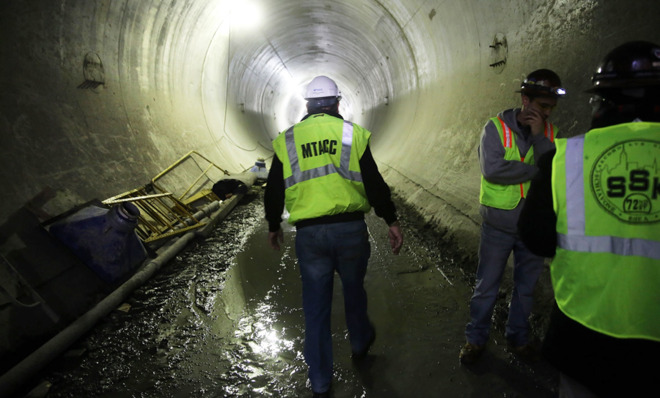Why is it so expensive to build a bridge in America?
The answer: Our greedy and undemocratic political culture


It's become commonplace to note that U.S. infrastructure costs are very high. What is less appreciated is the staggering scale of the difference between American infrastructure costs and those of other nations. Like our health care, U.S. infrastructure isn't just a tad higher than the next most expensive country — we pay something like twice as much as our closest peer (usually the U.K., which is itself a very expensive place). And when you compare America to, say, Spain, we're talking order-of-magnitude differences.
In other words, Spain, a developed market democracy, gets 10 to 20 times as much infrastructure for its money as America does, and it is of much higher quality to boot. Why is this?
People who have looked into the question have collected a range of fairly convincing explanations — though they come up short in a fundamental way. Let's quickly go through the major factors researchers have identified, in no particular order:
The Week
Escape your echo chamber. Get the facts behind the news, plus analysis from multiple perspectives.

Sign up for The Week's Free Newsletters
From our morning news briefing to a weekly Good News Newsletter, get the best of The Week delivered directly to your inbox.
From our morning news briefing to a weekly Good News Newsletter, get the best of The Week delivered directly to your inbox.
1. Expensive labor. From the top brass at New York's Metropolitan Transportation Authority: "The MTA is required to overstaff projects so that the same [tunnel boring machine] work, for instance, that can be done in Spain with nine workers must be done in [New York City] with 25 workers."
2. Out-of-control private contractors. From Stephen Smith at Bloomberg: "Agencies can't keep their private contractors in check. Starved of funds and expertise for in-house planning, officials contract out the project management and early design concepts to private companies that have little incentive to keep costs down and quality up."
3. A crap procurement process. The classic American way to pay for a big project is to round up about half of the funding (or even less), start construction, and then use a sunk-cost-fallacy to get the rest. This, obviously, is not conducive to efficient or speedy projects. (Looking at you, California high-speed rail.)
There are probably a lot more, but as Alon Levy points out, it would be a mistake to focus too much on particular techniques or failures. The reality is that when it comes to cost and quality, America is doing basically everything wrong. Again, we're not just a bit behind the curve — we're ridiculously, embarrassingly behind the curve.
A free daily email with the biggest news stories of the day – and the best features from TheWeek.com
The fact that both left- and right-aligned institutions (public employee unions and private contractors, respectively) are implicated here is evidence that this isn't a typical left-right situation. And if we look internationally, both Singapore (very free-markety) and Sweden (unembarrassedly socialist) manage much cheaper building costs than America.
This is basically about our greedy and opaque political culture.
Every American infrastructure project features a scramble on the part of all parties to skim as much for themselves as possible. This leads to a self-defeating cycle in which voters are reluctant to pay for new stuff, so elites try to fund new projects in a duplicitous way, which only leads to more cost overruns.
The U.S. is a low-trust society, by developed-world standards, and our infrastructure institutions are usually a complex, stunningly corrupt hodgepodge. It's nearly impossible to get transparently funded projects through our janky political institutions, so instead of doing the slow and patient work of building democratic support for a new project and explicitly voting for the needed spending, which can then be completed without fear of backlash, we try to hide it through "independent" authorities, or the tax code, or duplicitous ballot initiatives.
The classic example of the American style of infrastructure is Robert Moses' New York empire. Never elected to any office, he used political maneuvering and legal chicanery to install himself as the de facto emperor of New York City. He was by far the most important power broker in the city for 44 years, and controlled all infrastructure spending during that time. (Naturally, he nearly wrecked the place with highways.)
For a more recent example, look at the Port Authority, the supposedly independent transit agency that, as the Bridgegate scandal has revealed, is in fact a mess of patronage and corruption and always has been.
So when there's a new pot of money available for some infrastructure spending, nobody much considers value for the taxpayer or trying to do a good job for its own sake. They just try to grab what they can, because they can't trust anyone else not to do the same. Why should transit unions, for example, worry about economizing on labor when any worker givebacks would probably be devoured by agency executives or private contractors? And because these things are typically carried out through bizarre and complex legal machinery, the public can't figure out whom to hold responsible. Hence, they figure that infrastructure spending is just a bad deal.
The toxic nature of the process deep-sixes obvious win-win bargains, like cutting back on overstaffing to win more projects.
One might look at all this and despair, concluding that America is fundamentally incompetent and will never have nice things. But there are some reasons for optimism — and they start with getting our politics sorted out. An emergency, for example, can magically snap layers of corruption, and even lumbering monstrosities like the MTA are capable of awesome feats of efficiency. Just look at what happened after Hurricane Sandy:
It has been less than two weeks since the most devastating storm in the New York City subway system's 108-year history. Seven tunnels beneath the East River flooded. Entire platforms were submerged. Underground equipment, some of it decades old, was destroyed....
Less than three days after the storm hit, partial subway service was restored. Most major lines were back within a week. Repairs came so quickly in some cases that the authority was ready before Consolidated Edison had restored power.
"Some of what they're doing borders on the edge of magic," said Gene Russianoff, the staff lawyer for the Straphangers Campaign, a rider advocacy group that is frequently critical of the authority. [New York Times]
Public agencies managed even more stupendous feats back in World War II.
Now, it's a tall and rather vague order to demand that all political institutions be fixed. But when we have the option, we ought to think about abandoning the authority model and folding our infrastructure institutions into more democratically responsible structures. And we should definitely vote for political candidates who advocate such changes.
Ryan Cooper is a national correspondent at TheWeek.com. His work has appeared in the Washington Monthly, The New Republic, and the Washington Post.
-
 Political cartoons for December 23
Political cartoons for December 23Cartoons Tuesday's political cartoons include an eye on CBS, cracking the middle class, and Donald Trump's name on everything
-
 Why women are feeling the festive stress
Why women are feeling the festive stressTalking Point As the Christmas frenzy ramps up, many mums feel the pressure of ‘keeping the whole sleigh on the road’
-
 Is Keir Starmer being hoodwinked by China?
Is Keir Starmer being hoodwinked by China?Today's Big Question PM’s attempt to separate politics and security from trade and business is ‘naïve’
-
 Has Zohran Mamdani shown the Democrats how to win again?
Has Zohran Mamdani shown the Democrats how to win again?Today’s Big Question New York City mayoral election touted as victory for left-wing populists but moderate centrist wins elsewhere present more complex path for Democratic Party
-
 Millions turn out for anti-Trump ‘No Kings’ rallies
Millions turn out for anti-Trump ‘No Kings’ ralliesSpeed Read An estimated 7 million people participated, 2 million more than at the first ‘No Kings’ protest in June
-
 Ghislaine Maxwell: angling for a Trump pardon
Ghislaine Maxwell: angling for a Trump pardonTalking Point Convicted sex trafficker's testimony could shed new light on president's links to Jeffrey Epstein
-
 The last words and final moments of 40 presidents
The last words and final moments of 40 presidentsThe Explainer Some are eloquent quotes worthy of the holders of the highest office in the nation, and others... aren't
-
 The JFK files: the truth at last?
The JFK files: the truth at last?In The Spotlight More than 64,000 previously classified documents relating the 1963 assassination of John F. Kennedy have been released by the Trump administration
-
 'Seriously, not literally': how should the world take Donald Trump?
'Seriously, not literally': how should the world take Donald Trump?Today's big question White House rhetoric and reality look likely to become increasingly blurred
-
 Will Trump's 'madman' strategy pay off?
Will Trump's 'madman' strategy pay off?Today's Big Question Incoming US president likes to seem unpredictable but, this time round, world leaders could be wise to his playbook
-
 Democrats vs. Republicans: who do the billionaires back?
Democrats vs. Republicans: who do the billionaires back?The Explainer Younger tech titans join 'boys' club throwing money and support' behind President Trump, while older plutocrats quietly rebuke new administration
